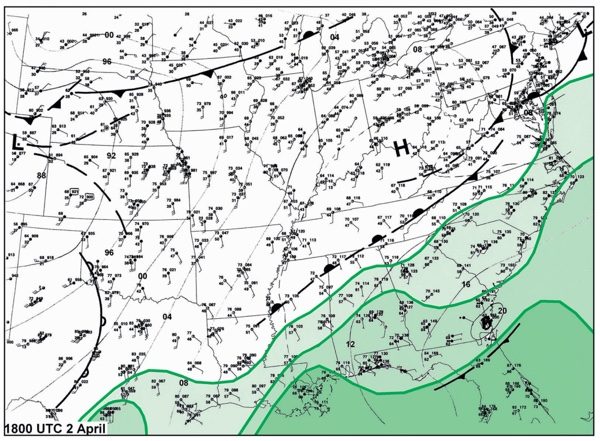April 2, 1974: A Momentous Heads Up Phone Call
We take advance forecasts of severe weather for granted today, with up to a week of advance notice for big storm systems. But it has not been that way for very long.
On the morning of April 2, 1974, Mr. Robert Ferry, the Meteorologist in Charge of the National Weather Service Forecast office in Birmingham received a call from Allen Pearson, Director of the National Severe Storms Forecast Center in Kansas City. Dr. Pearson started the call asking about the tornadoes that had popped through the state of Alabama the night before.

Surface map from 1 p.m. CDT April 2, 1974. From Corfidi, et al.
Two F2 tornadoes had produced some damage and one fatality. The first, near Huntsville, had resulted in the fatality. Another tornado had skipped across Blount County, destroying several mobile homes in a mobile home park near Oneonta. Mr. Ferry said that although things had been bad, they could have been a lot worse.
Dr. Pearson said told Mr. Ferry that if he thought the April Fools Day weather was rough, just wait until Wednesday.
It was already apparent to forecasters that a massive outbreak of severe weather was likely the next day. A strong upper level trough was located over the Great Basin of the western U.S. A broad area of surface low pressure was centered over Colorado, Utah and Wyoming. The central pressure was already down to 991 millibars. This dynamic low pressure system was poised to bring copious amounts of rich Gulf moisture northward.
Pearson was notifying National Weather Service Offices across a large area east of the Mississippi River that there would be a large tornado outbreak over the next two days. He asked that the field offices prepare for the potential severe weather by performing maintenance on their equipment and radars. He also asked the MICs to alert personnel that some might be asked to work extra hours or be called in to work on their off day. Preparations were made for the ATS-3 satellites to be operated in a severe weather mode the following day. Special balloon releases were set for midnight that night.
Tornado watches were posted by the evening hours across parts of Texas, Oklahoma and Arkansas. Severe weather reports were minimal from this opening round of weather from the powerful system. Forecasters knew trouble was brewing, but had no idea how bad it would be.
A total of 148 tornadoes occurred in 24 hours across the eastern United States, including 30 violent tornadoes. The Superoutbreak was unprecedented in many categories, including: total tornadoes (148); total path length (1700 miles) and number of violent tornadoes (30). There 315 people were killed in eleven states, including 34 people that died in the town of Xenia, Ohio alone. Damage totaled $500 million.
Image Source: Corfidi, Stephen F., & Weiss, Steven J. (2010). Revisiting the 3-4 1974 Super Outbreak of Tornadoes. Weather and Forecasting, Volume (25), pp 465-510.
Category: ALL POSTS, Met 101/Weather History















